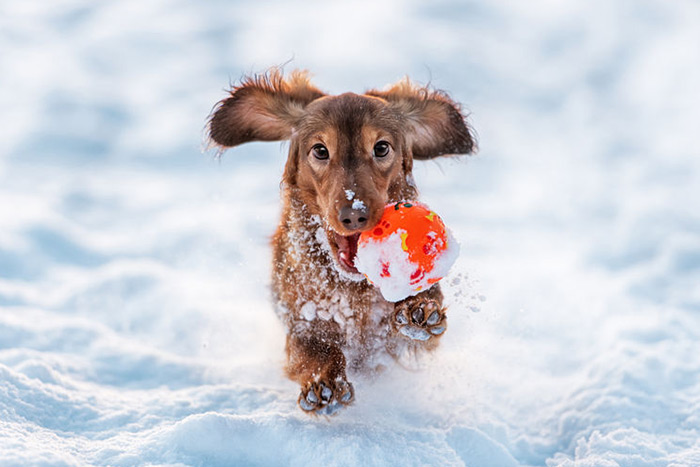How to Care for Your Dog and Stay Safe in the East End Winter Cold

A good rule of thumb is, if you’re too cold to be outside, so is your dog. But like most people, most dogs enjoy winter fun outdoors.
With the right preparation, there’s no reason why our four-legged friends can’t frolic in the snow and relish the winter weather. It’s our responsibility as owners to make sure they do it safely.
A dog’s coat is essential for protecting his skin, shading him from the sun in warm weather and keeping him warm in the cold. Going in and out of the cold can dry your dog’s skin. Brushing dogs is a way to remove dead skin cells and increase circulation. Bathing also helps—just be sure to completely dry your pup after washing.
Many people believe regular bathing is not good for dogs, but this isn’t necessarily the case. It won’t be a problem if you keep baths to one per week and use the right shampoo. Never use human shampoo, designed for our more acidic pH. Find a shampoo pH balanced for dogs’ more alkaline skin. petmd.com suggests a neutral 7 pH, which is a solid bet for most dogs.
Many dogs, just like children, love to play in the snow. It’s important to keep your best friend safely confined within a fenced yard or on a leash during walks. Maintaining close handle on your dog’s leash is crucial when strolling along roads where cars could lose control while braking on snow and ice.
Winter is the worst time to lose track of a dog. They use their sense of smell to find the way home, and this is more difficult when everything is covered in snow. Smaller dogs, especially white ones, are also very hard to see in deep powder. They can be more prone to wander, which could lead to getting buried in snow or falling into snow or ice covered water.
While it’s true that many small dogs struggle with the cold, size isn’t always the determining factor. If you choose to dress your dog for the cold, stay away from bulky coats that inhibit movement. Windproof material lined with polar fleece for comfort and warmth allows your dog to move freely and stay warm. The coat shouldn’t fit too tightly or be too loose. Any rubbing parts could irritate.
Protecting your dog’s chest, back and flanks is important, but the winter can also be brutal on their paws. Before going out, you can apply Musher’s Secret, a paw wax developed for sled dogs that forms a protective barrier over your pup’s pads. If you can’t find Musher’s, try Bag Balm or Vaseline.
Longhaired dogs should have the fur trimmed short around their pads, which will prevent ice balls from forming between the digital and metacarpal pads. A dog’s pads are also vulnerable to salt, de-icing chemicals and sharp ice or objects hidden beneath the snow. It’s a good idea to keep a bowl of lukewarm water along with a towel by your front door to rinse away chemicals and dry your dog’s feet after coming inside.
Depending on your dog’s coat and the type of snow, ice balls can also form on your dog’s legs and belly. When the snow packs easily, it forms ice balls on longer haired dogs, but the lukewarm water will melt them right off. Avoid using hot water, which will cause pain.
It’s just as important to keep your dog hydrated in the winter as it is in the warmer seasons. Dogs burn calories and energy as their bodies attempt to keep warm.
Of course the best place for dogs in the coldest weather is inside a warm home on a cozy bed.
Colleen Peterson is the owner and operator of Petite Dog Care in Center Moriches, a home-based dog care business for small breeds—email petitedogcare@gmail.com or visit her Instagram, @petitedogcare, for more information.



